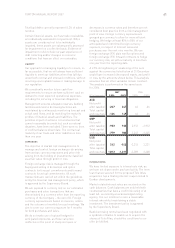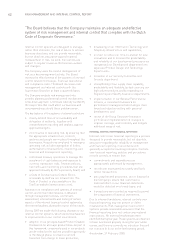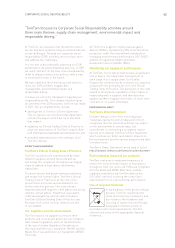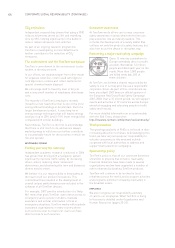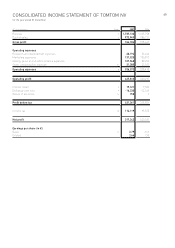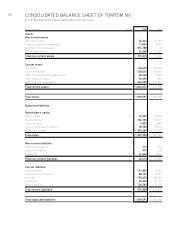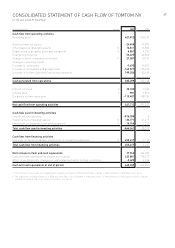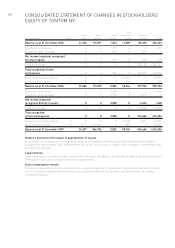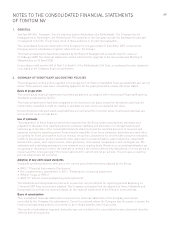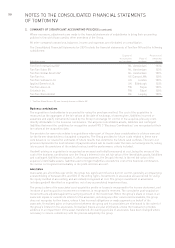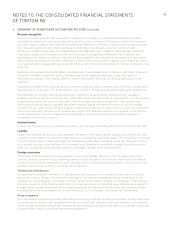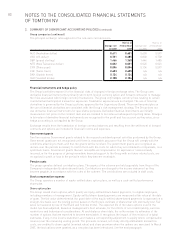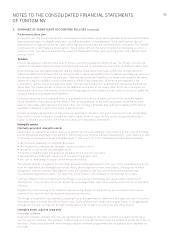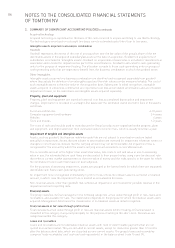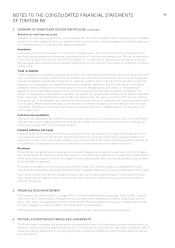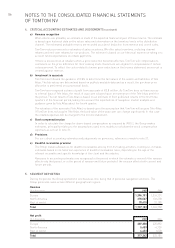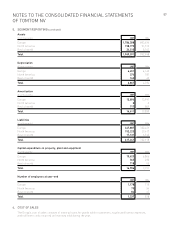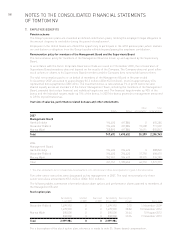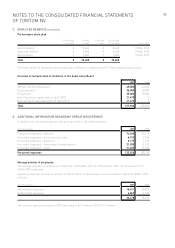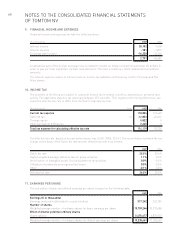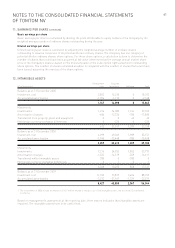TomTom 2007 Annual Report Download - page 57
Download and view the complete annual report
Please find page 57 of the 2007 TomTom annual report below. You can navigate through the pages in the report by either clicking on the pages listed below, or by using the keyword search tool below to find specific information within the annual report.
51
NOTES TO THE CONSOLIDATED FINANCIAL STATEMENTS
OF TOMTOM NV
2. SUMMARY OF SIGNIFICANT ACCOUNTING POLICIES (continued)
Revenue recognition
Revenue is measured as the fair value of the consideration received or receivable and represents amounts
receivable for goods and services provided in the normal course of business. Revenue is reduced for estimated
customer returns, rebates and other similar allowances. Revenue on the sale of goods is only recognised when
the risks and rewards of ownership of goods are transferred to the Group’s customers (which include
distributors, retailers, end-users and Original Equipment Manufacturers (“OEMs”)). The risks and rewards of
ownership are generally transferred at the time the product is shipped and delivered to the customer and,
depending on the delivery conditions, title and risk have passed to the customer and acceptance of the product,
when contractually required, has been obtained. In cases where contractual acceptance is not required, revenue
is recognised when management has established that all aforementioned conditions for revenue recognition have
been met.
Examples of the above-mentioned delivery conditions are ‘Free on Board point of delivery’ and ‘Costs, Insurance
Paid point of delivery’, where the point of delivery may be the shipping warehouse or any other point of
destination as agreed in the contract with the customer and where title and risk in the goods passes to the
customer.
Estimates are made of the financial impact of returns, as well as sales incentives, based on historical data and
expectations of future sales. For further details, refer to note 4, Critical Accounting Estimates and Judgements.
Bundled sales or multiple-element arrangements require the Group to deliver equipment (e.g. navigation
hardware) and/or a number of services (e.g. traffic information services) under one agreement, or under a series
of agreements which are commercially linked. In such multiple-element arrangements, the consideration
received is allocated to each separately identifiable element, based on relative fair values or on the residual
method. The fair value of each element is determined based on the current market price of each of the elements
when sold separately. The amount of revenues allocated to the hardware element is recognised in line with the
accounting policy for the sale of goods as described above. The revenue relating to the service element is
recognised over the service period.
Interest income
Interest income is accrued on a time basis, based on the principal outstanding and at the effective interest rate.
Leasing
Leases areclassified as finance leases whenever the terms of the lease transfer substantially all the risks and
rewards of ownership to the lessee. All other leases are classified as operating leases. The Group has not entered
intoany material finance leasing arrangements. Rentals payable under operating leases are charged to income
on a straight-line basis over the term of the relevant lease. Benefits received and receivable as an incentive to
enter into an operating lease are also spread on a straight-line basis over the lease term.
Foreign currencies
The Group’sprimary activities aredenominated in euros. Accordingly, the euro is the Company’s functional
currency, which is also the Group’s reporting currency. Items included in the financial information of individual
entities in the Group are measured using the individual entity’s functional currency, which is the currency of the
primary economic environment in which the entity operates.
Transactions and balances
In preparing the financial information of individual entities, transactions in currencies other than this entity’s
functional currency (foreign currencies) are recorded at the rates of exchange prevailing on the dates of the
transactions. At each balancesheet date, monetary items denominated in foreign currencies are retranslated at
the rates prevailing at the balance sheet date. Non-monetary items carried at fair value that are denominated in
foreign currencies are retranslated at the rates prevailing at the date when the fair value was determined. Non-
monetary items that are measured in terms of historical cost in a foreign currency are not retranslated.
Group companies
For consolidation purposes, the assets and liabilities of foreign entities that have a functional currency other than
our presentation currency are translated at the year-end spot rate, whereas the income statement is translated
at the average monthly exchange rate. Translation differences arising thereon are taken to a separate component
of shareholders’ equity (cumulative translation adjustment).


